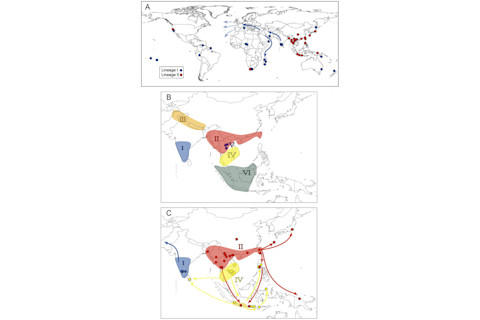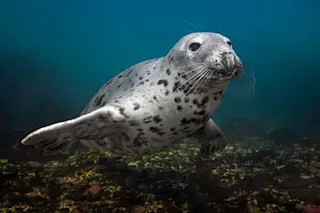
The above is a figure from a new paper in PLoS ONE, Multiple Geographic Origins of Commensalism and Complex Dispersal History of Black Rats. Here's the abstract:
The Black Rat (Rattus rattus) spread out of Asia to become one of the world's worst agricultural and urban pests, and a reservoir or vector of numerous zoonotic diseases, including the devastating plague. Despite the global scale and inestimable cost of their impacts on both human livelihoods and natural ecosystems, little is known of the global genetic diversity of Black Rats, the timing and directions of their historical dispersals, and the risks associated with contemporary movements. We surveyed mitochondrial DNA of Black Rats collected across their global range as a first step towards obtaining an historical genetic perspective on this socioeconomically important group of rodents. We found a strong phylogeographic pattern with well-differentiated lineages of Black Rats native to South Asia, the Himalayan region, southern Indochina, and northern Indochina to East Asia, and a diversification that probably commenced in the early Middle Pleistocene. We also identified two other currently recognised species of Rattus as potential derivatives of a paraphyletic R. rattus. Three of the four phylogenetic lineage units within R. rattus show clear genetic signatures of major population expansion in prehistoric times, and the distribution of particular haplogroups mirrors archaeologically and historically documented patterns of human dispersal and trade.
Commensalism clearly arose multiple times in R. rattus and in widely separated geographic regions, and this may account for apparent regionalism in their associated pathogens.
Our findings represent an important step towards deeper understanding the complex and influential relationship that has developed between Black Rats and humans, and invite a thorough re-examination of host-pathogen associations among Black Rats.
Since it is open access you can read the paper for the full details. The main result is that
it looks like separate and distinction lineages of R. rattus piggybacked on the expansion of humans.
The main caveat, admitted in the article, is a reliance on mtDNA and the possibility of admixture and introgression across lineages explaining the current extant variance. The authors refer to paraphyly because it may be that all the descendants of modern black rats, as we understand them, may not be identified as black rats, probably due to their lack of adaptation and coexistence with humans. Obviously we'll need to wait for autosomal studies which utilize many more markers. But let's grant the robustness of this finding: that the modern black rat lineages are a compound of a recent demographic expansion from a small population in western India, as well as long standing deep rooted populations across South and Southeast Asia, which independently entered into coexistence and parasitism with humans. I find this broadly plausible. The reason is not the rat, but the dog. A new paper just came out which established an East Asian origin for dogs. Or at least for now, as there have been multiple candidates for point of origin. Additionally there are some who argue for evidence of pre-Neolithic domestication or coexistence of dogs and humans. I am beginning to suspect that this hodgepodge of confusing results on the origin of the dog, both in location and period,
indicates that in some deep way the wild ancestors of dogs were pre-adapted for coexistence with humans, and it may have occurred multiple times.
This is the argument in Mark Derr's How the Dog Became the Dog: From Wolves to Our Best Friends. My position isn't that modern dogs aren't the descendants of a small ancient population which crystallized in the early Neolithic. Rather, it may be that they're just the last in a long line of dog-human co-socialization experiments. With the radiation of the hominin clade, and its shift toward more complex social organizational structures, the evolution of parasites like rats and companion species like dogs was inevitable. Out of the set of species which exhibit a potential toward close interaction with humans you have a small number which are ideally pre-adapted. Often this pre-adaptation isn't a universal feature of a species, but part of the quantitative range of trait value. In other words, there may have been wolves always present which would be more congenial to interaction with hominins, and rats which were optimized for living on the margins and within human settlements. When humans become numerous, these previously neutral or lower frequency morphs became strong targets of natural selection.













